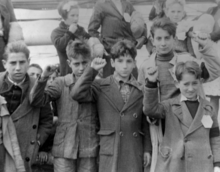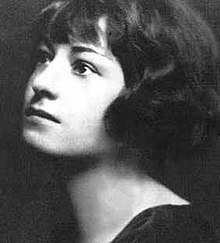Joint Anti-Fascist Refugee Committee
 Children preparing for evacuation, some giving Spanish Republican salute (raised fist) | |
| Formation | 1941 |
|---|---|
| Founder | Edward K. Barsky |
| Founded at | New York City |
| Dissolved | 1955 |
| Merger of | North American Committee to Aid Spanish Democracy, American Medical Bureau |
| Headquarters | New York City |
| Location |
|
| Coordinates | 40°44′42″N 73°58′51″W / 40.745054°N 73.980882°W |
| Services | Humanitarian aid for Spanish Civil War refugees |
National Honorary Chairman | Walter Rautensrauch |
National Chairman | Edward K. Barsky |
Secretary | Helen R. Bryan |
Treasurer | Lyman R. Bradley |
| Website | Official website |
Joint Anti-Fascist Refugee Committee (JAFRC) was a nonprofit organization to provide humanitarian aid to refugees of the Spanish Civil War.[1][2]
History

In 1941, the Joint Anti-Fascist Refugee Committee was formed by
The JAFRC established a fundraising organization, the Spanish Refugee Appeal of the Joint Anti-Fascist Refugee Committee.[1][3] Dorothy Parker took charge of the fundraising of the committee, which soon attracted the support of Leonard Bernstein, Albert Einstein, Lillian Hellman, Langston Hughes, and Orson Welles.[4]
In 1942, the committee was licensed to do so in
In 1946, the committee began to face relentless criticism and scrutiny from federal government organizations. In 1948, the Bureau of Internal Revenue (now known as the Internal Revenue Service) revoked the JAFRC's tax-exempt status. Following this, the Subversive Activities Control Board (SACB) attempted to compel the JAFRC to register as a communist front organization.n.[1]
In April 1951,
In 1955, the committee's board voted to disband.[1]
People
Leaders
According to letterhead dated March 17, 1944,[7] leaders included:
- Walter Rautenstrauch, National Honorary Chairman
- Edward K. Barsky, National Chairman
- Lyman R. Bradley, National Treasurer[8]
- Helen R. Bryan, National Secretary
National Sponsors[7] included:
- Dr. Comfort A. Adams
- Rabbi Michael Aper
- Dr. Hery Lambert Bibby
- James L. Brewer
- Dr. Walter B. Cannon
- Prof. Richard T. Cox
- Martha Dodd
- Julien Duvivier
- Dr. Frederick May Eliot
- Dr. Henry Pratt Fairchild
- Lion Feuchtwanger
- Prof. Irving Fisher
- Prof. Mitchell Franklin
- Rev. Stephen H. Fritchman
- Prof. Marion Hathaway
- Kenneth Leslie
- Princess Helga zu Loewenstein
- Dr. Robert Morss Lovett
- Prof. Kirtley F. Mather
- Philip Merivale
- Rt. Rev. Edward L. Parsons
- Prof. Renato Poggioli
- Dr. Francis M. Pottenger
- Paul Robeson
- Prof. Harlow Shapley
- Dalton Trumbo
- Dame May Whitty
- Dr. Max Yergan
Members
- Moses Fishman
- Mark Straus MD[9]
- Arthur Szyk (alleged)
Spanish Refugee Appeal supporters

- Pablo Picasso, Honorary Chair
- Dorothy Parker, Chairman
National Sponsors[4][3][10] included:
- Rev. Dr. Charles B. Ackley
- Lemuel Ayers
- Aline Bernstein
- Leonard Bernstein
- Alvah Bessie
- Lyman R. Bradley
- Dorothy Brewster
- Arthur G. Brodeur
- Henrietta Buckmaster
- Rabbi Elliott Burstein
- Allan Chase
- Edward Chodorov
- John M. Coffee
- Rabbi J. X. Coeh
- Charles A. Collins
- Eugene P. Connolly
- Kyle Crichton
- Bartley C. Crum
- Bernard Davidoff
- Agnes George De Mille
- Mrs. George Adams Dewey
- Earl B. Dickerson
- Dean Dixon
- Martha Dodd
- Olin Downes
- Muriel Draper
- Albert Einstein
- Rabbi Mitchel S. Eskolsky
- Philip Evergood
- Henry Pratt Fairchild
- L.S. Fanning
- Howard Fast
- Lion Feuchtwanger
- Louis Finger
- Elizabeth P. Frazier
- Rve. Stephen Fritchman
- Betty Garrett
- Frank Gervasi
- Elinor S. Gimbel
- Rabbi Solomon Goldman
- Robert Gordis
- William Gropper
- Chaim Gross
- Ralph H. Grundlach
- Richard Gump
- Ralph Gundlach
- Marion Hathaway
- Rita Hayworth
- Lillian Hellman
- Libby Holman
- Langston Hughes
- Walter Huston
- Stanley M. Isaacs
- Mrs. Sydney Joseph
- Barney Josephson
- Rober W. Kenny
- Rockwell Kent
- Fiske Kimball
- Arthur Kober
- Alfred Kreymborg
- Canada Lee
- M.V. Leof
- Kenneth Leslie
- Ray Lev
- Walter H. Leibman
- Daniel A. Longbaker
- Louis Lozowick
- Florence J. Luscomb
- Richard Lyndon
- Louis F. McCabe
- John T. McManus
- Rev. Dr. John D. Mackay
- Manuel Magana
- Albert Maltz
- Alfred T. Manacher
- Richard Maney
- Heinrich Mann
- Thomas Mann
- Alicia Markova
- George Marshall
- Kirtley F. Mather
- F.O. Matthiesen
- Rev. William Howard Melesh
- Yehudi Menuhin
- Saul Mills
- James K. Moffitt
- Pierre Monteux
- Karen Morley
- William Morris Jr.
- Zero Mostel
- Jarmila Novotná
- Michael J. Obermeier
- Harvey O'Connor
- Eugene O'Neill
- Isabel de Palencia
- Aubrey Pankey
- Beryl Parker
- Edward L. Parsons
- J. Gilbert Peirce
- Gerry Pelles
- Gregor Piatigorsky
- David de Sola Pool
- Adam Clayton Powell Jr.
- Walter Rautenstrauch
- Anton Refregier
- John Reiner
- Quentin Reynolds
- Paul Robeson
- William M. Rubin
- Mrs. Maurice Bower Saul
- Jimmy Savo
- Geoges Schreiber
- Hazel Scott
- Anna Seghers
- Lisa Sergio
- Harlow Shapley
- Sol Silverman
- Hilda Simms
- Edgar Snow
- Moses Soyer
- Johannes Steel
- Vilhjalmur Stefansson
- Mark Straus
- Jack Strauss
- Arthur Szyk
- Genevieve Tabouis
- Dalton Trumbo
- M.S. Vidaver
- Harry F. Ward
- Morris Watson
- Margaret Webster
- Orson Welles
- Mrs. Philip E. Wilcox
- Mitchell Wilson
- Carl Zigrosser
- Leane Zugsmith
See also
- Joint Anti-Fascist Refugee Committee v. McGrath
- North American Committee to Aid Spanish Democracy
- American Medical Bureau
- Lincoln Battalion
References
- ^ a b c d e "Guide to the Joint Anti-Fascist Refugee Committee Records ALBA.057". New York University. 20 July 2017. Retrieved 27 September 2018.
- ^ a b
Deery, Phillip (December 2009). ""A blot upon liberty": McCarthyism, Dr. Barsky and the Joint Anti-Fascist Refugee Committee" (PDF). S2CID 154499275. Retrieved 4 March 2018.
- ^ a b c "Circular letter from Joint Anti-Fascist Refugee Committee to W. E. B. Du Bois". University of Massachusetts. 21 February 1952. Retrieved 27 September 2018.
- ^ a b "Guide to the Joint Anti-Fascist Refugee Committee Records ALBA.057". Tamiment Library and Robert F. Wagner Archives. New York University. Retrieved 4 March 2018.
- S2CID 55127837. Retrieved 4 March 2018.
- ^ "Anti-Fascist Committee v. McGrath". Washington: Find Law. 30 April 1951. Retrieved 26 August 2017.
- ^ a b "Letter to J.W. Pehle of War Refugee Board" (PDF). Franklin Delano Roosevelt Library. 17 March 1944. Retrieved 27 September 2018.
- ^ "Circular letter from Joint Anti-Fascist Refugee Committee, February 24, 1950". University of Massachusetts. 24 February 1950. Retrieved 27 September 2018.
- ^ Straus, MD, Mark (13 February 1952). "Letter from Joint Anti-Fascist Refugee Committee to Mayor of the City of New York". Joint Anti-Fascist Refugee Committee. Retrieved 27 September 2018.
- ^ a b "Letter from Joint Anti-Fascist Refugee Committee to W. E. B. Du Bois". University of Massachusetts. 6 April 1949. Retrieved 27 September 2018.

